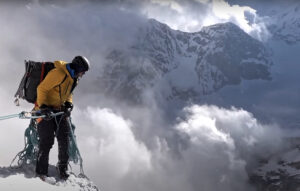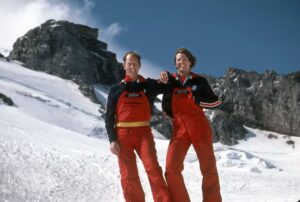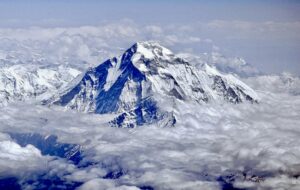John Colter was one of the best hunters of the 19th century. He mapped uncharted parts of Blackfoot territory in the western U.S. with Lewis and Clark. When their expedition ended, he spent six years trapping, often alone, and may have been the first explorer to see Yellowstone National Park. But his daring escape from the Blackfoot cemented his legacy.
A fateful meeting with Meriwether Lewis
By the time that Colter was 35, frontier living had already given him impressive skills. Meriwether Lewis met him accidentally in 1803. Recognizing Colter’s value, Lewis swiftly offered him five dollars a month to join his and William Clark’s expedition. This chance encounter began Colter’s career as an explorer.
President Thomas Jefferson commissioned the Lewis and Clark expedition to cross the Western United States, mapping and creating practical routes.
Colter wasn’t immediately diligent. Often, he larked about drunk with other men. When his captains were away, he disobeyed orders. Once, he was court-martialed.
At the same time, Colter was one of the best hunters on the expedition. His skills fed the crew, and he routinely scouted new trails.
As he became increasingly focused, Lewis and Clark increased his responsibilities. When Clark needed to send a message to the absent Lewis, he chose Colter for the job. When horses went missing, Colter tracked them down.
Colter didn’t mind hunting alone. During the winter of 1805-1806, he focused on elk. These big animals had become increasingly rare.
Cool under pressure
Even more critical was Colter’s ability to stay cool in emergencies. Once his horse buckled beneath him during a river crossing. They drifted downstream, rolling and crashing over top of each other. Escaping with minor injuries, Colter even saved his rifle.

Lewis and Clark expedition route. Map: Legends of America
With Lewis and Clark, Colter was instrumental in finding passes through the Rocky Mountains. He was a focused hunter who enjoyed navigating uncharted territories. The wilderness was his preferred environment.
Three years later, the expedition was returning to Missouri, but Colter wasn’t ready to leave. Fur trappers Forrest Hancock and Joseph Dickson were headed toward Yellowstone and Colter was eager to join them. He requested a discharge from Lewis and Clark to join Hancock and Dickson. But the new trio didn’t last long.
First, they turned back up the Missouri River toward Yellowstone country. For six weeks, they trapped beaver before disagreements forced Hancock and Colter to carry on without Dickson. Soon after, Colter split up from Hancock and continued solo down the Missouri River toward St. Louis.
Although he was content exploring alone, a fresh opportunity was on the horizon. But it came with risks.
Adventures in the fur trade
Manuel Lisa of the Missouri Fur Company stumbled upon Colter paddling alone up the Platte River. Lisa’s party was heading up the Yellowstone River and he hired Colter to guide them down the Big Horn River. Lisa knew Colter’s skills would be critical to securing trade deals.
Colter first led the party to the Yellowstone River, where they built Fort Raymond. Soon after, he left alone to meet with local Indian groups and explain the fur company’s desire to trade.
With just a pack and rifle, Colter traveled over 800km through Crow country, building relationships with tribes as he went. He crossed the Wind River Mountains and the Teton Range during winter.
He witnessed geysers, braved sub-zero temperatures, and spent most of his time alone. When he arrived at Jackson Hole and Yellowstone Lake, he was likely the first white man to do so.
Returning to Fort Raymond, he described the geothermal activity and splendor of Yellowstone Lake to disbelieving ears. In 1808, he set off again, this time with colleague John Potts from the Lewis and Clark Expedition.
Blackfoot hostilities
The pair was traveling west toward the Three Forks of the Missouri when the first of two Indian attacks occurred.
As the men were leading 800 Crows back to Fort Raymond, a rival tribe of 1,500 Blackfoot set upon them. Despite a wounded leg, Colter continued to return fire while sheltering beneath scrub. Overpowered, the Blackfoot retreated and Colter returned to Fort Raymond to recover.
Blackfoot warriors were intolerant of white men. Years earlier, the Lewis and Clarke expedition had killed one who was found stealing a horse. Since then, the Blackfoot had sought revenge.
The following year, when Potts and Colter were hunting beavers, they knew they were at risk of Blackfoot attack. But the trapping was too good to pass up.
Carefully, they devised a plan to set traps after dark when the Blackfoot were sleeping. But one morning, while pulling out traps which they had set the evening before, a sound startled them.
Unsure if it was buffalo or Blackfoot, they continued paddling their canoe upstream. Within moments, they were surrounded by Blackfoot Indians beckoning from the river bank.
As Colter and Potts came to shore, a Blackfoot grabbed Potts’ rifle. Colter acted quickly, wrestling the rifle free. He returned it to Potts, who then shot the Indian. Instantly, Potts received a fatal flurry of arrows.
Keeping his cool, Colter looked for a chance to bargain for his life. The Indians stripped him naked, discussing among themselves how to kill him.
Colter’s run
Colter didn’t know their language well but he understood enough. They wanted to save him for their chief to use as a moving target. Colter lied, explaining that he was a poor runner. He hoped that it would buy him an opportunity.
The chief set Colter loose with Indians running after him. For 10km, Colter ran naked through cactus fields, with more than 100 Blackfoot on his tail. He was such a swift runner that he eventually out-distanced them all, except for one spear-wielding man.
Wheeling around unexpectedly, Colter caught his pursuer by surprise. The Blackfoot man fell to the ground, snapping his spear. Colter picked up the broken lance and held it to the Indian’s throat.
But the rest of the Indians were approaching quickly, and Colter needed to make a quick escape. Drawing on all his speed and strength, he managed to outrun the tribe, eventually plunging into a river. He submerged and hid beneath driftwood, breathing pockets of air.
Colter waited until it was dark and the Blackfoot had abandoned the chase. He was naked and a long way from the nearest trading post. It took Colter a week to return to camp. When he did, he was sunburned and starving.
More close calls
His encounters with Blackfoot weren’t over. In the following years, they pursued him many times. Each time, he emerged a little more battered. Eventually, he tired of the chase and quit trapping altogether. He’d spent more than six years in the wild.

Historical marker in Stuart’s Draft, Virginia.
Eventually, he and Clark created a comprehensive map of the region they’d explored. It stood as a model of detail and accuracy for the next 75 years.
Colter tried to settle down to quiet farm life in Missouri with his new wife. But when the United States fought Great Britain in the War of 1812, a restless Colter enlisted. It was his final expedition. He succumbed to jaundice while at war.
Nowadays, we mostly remember Colter for his miraculous escape from the Blackfoot. He was also one of America’s first true “Mountain Men”.
More than a century later, in the 1930s, a farmer west of the Tetons discovered a stone with “John Colter” carved on one side and “1808” on the other. Historians still hotly debate whether the stone is authentic.






